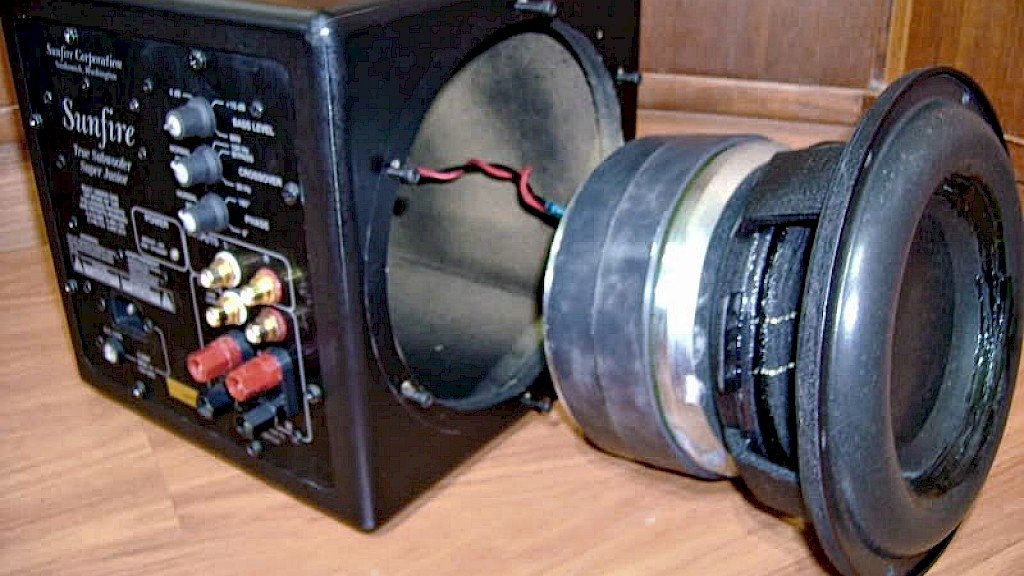Big Woofers Give Better Bass – Maybe.
Big woofers mean better bass to most people. In general, big woofers (which take big cabinets) can produce more output than small woofers in small boxes. Does this mean better bass? This is not so clear.
Definition and Opinions
Better bass means many different things to different people:
- To the pipe organ and 1812 Overture lovers, it means bass that goes lower in frequency at audible levels.
- To the rock ‘n roll lovers it usually means more output around 40-60 Hz.
- To the movie lovers, it is feeling the Tyrannosaurus rex before seeing the glass of water shake. And there can never be enough bass to reproduce an atomic bomb.
- To many speaker buyers it means seeing a big woofer or subwoofer.
- To the speaker designers, these translate into either a lower cutoff frequency (where you stop hearing the bass at normal listening levels) or more output in the region above the cutoff frequency or a combination of both.
As a speaker designer and music lover, I tell speaker buyers to choose with their ears, not their eyes.
When comparing different brands, what you see in the size of the woofer and what you read in the specifications may have little relation to what you will hear in your room with your placement and your equipment. Trying the speakers in your own home is only way to learn what the speaker can and cannot do.
Room Size
Your room size and shape will have a dramatic effect on the bass you hear from any speaker. When you double the room interior volume, you need to double the amount of deep bass you put into the room to have sound balance be the same. (Remember: since the interior volume is width times the depth times the height, increasing each dimension slightly can have a big net change in the room volume.) A speaker sounding full and providing a good foundation to music in a small room can sound thin and weak in a bigger room. It is the balance of bass to the midrange and treble that is critical. The optimal balance is for each room, not for each speaker. So, again, you need to listen in your room…
Cabinet size, Hoffman’s Iron Law, and the Thiele/Small Vented Variations
There is also the size of the cabinet that encloses the woofer. Big cabinets are generally better for producing better bass. The relationship was spelled out by J. Anthony Hoffman (the H of KLH) when he stated that with these three variables: internal cabinet size, speaker efficiency and low cutoff frequency, the speaker designer can choose any two but the third is totally determined by those choices. So a bigger cabinet size can give you a deeper cutoff frequency for a fixed efficiency. This was particularly true with the acoustic suspension designs popularized by AR and KLH of the day.
Thiele and Small demonstrated you could beat those acoustic suspension limits with a properly designed, vented system where you get some benefit from the cabinet/vent resonance. The tradeoff was a much faster drop in the bass below the cutoff frequency and some potential excursion problems in the deepest bass. Really big cabinets can help the bass; but there are user concerns when cabinets get too large – their cosmetics have limited appeal.
Subscribe to Ohm News & Views to get the latest posts in your inbox
Limitations: Excursion and Power
Woofers of all sizes have limitations where bigger can help extend some of those limits. The maximum loudness of a woofer is limited by the maximum volume of air the woofer can move in a fixed time period. The total volume of air (aka the displacement) is the total moving area of the moving parts of the driver times the total maximum excursion of those parts. If you double the excursion, you can reduce the total moving area by half and have the same total displacement. This means a 10” woofer can match the output of a 15” woofer if the 10” woofer has about twice the excursion. Bigger is only better when both drivers have similar excursion. But, it is also easier to have longer maximum excursion when you are dealing with bigger parts.
You might have noticed that with Hoffman’s Iron Law, you can have very deep bass in a small box if you are willing to have low efficiency. You can cut the box volume in half if you are willing to put twice as much energy into the speaker. If you take this path too far, you soon burn out the parts of the woofer when they cannot dissipate all the heat. If you put a few thousand watts into an 11” cube, you can get the deep bass of a typical 15” subwoofer. But, the 10” woofer must have enough excursion and heat dissipation not to burn out with all the power going in. This was the challenge Bob Carver gave me when he hired Ohm to help him design the original Sunfire True Subwoofer. A vented system was designed and Bob provided the amplifier with both thermal and mechanical protection for the woofer.
Conclusion
To get the best bass for your needs, use your ears – not your eyes. Listen in your own room, with your own electronics, with your own sources. Make your test at the levels where you expect to listen most often. Big does not mean better, but big can be better and easier for the designer!
Enjoy and Good Listening!
John
John Strohbeen Author
John Strohbeen was the President and Chief Engineer of Ohm Acoustics from 1978-2023.


